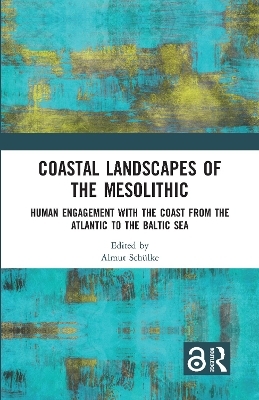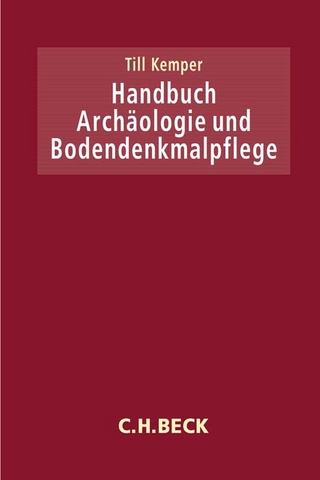
Coastal Landscapes of the Mesolithic
Routledge (Verlag)
978-1-032-17378-8 (ISBN)
Mesolithic people were strongly connected to the sea, with coastal areas vital for subsistence and communication across the water. This anthology includes case studies from Scandinavia, western Europe and the Baltic area, presented by key international researchers. Topics addressed include large-scale analyses of the archaeological and geological development of coastal areas, the exploration of coastal environments with interdisciplinary methods, the discussion of the character of coastal settlements and of their possible networks, social and economic practices along the coast, as well as perceptions and cosmological aspects of coastal areas. Together, these topics and approaches contribute in an innovative way to the understanding of the complexity of topographically changing coastal areas as both border zones between land and sea and as connecting landscapes.
Providing novel insights into the study of the Mesolithic as well as coastal areas and landscapes in general, the book is an important resource for researchers of the Mesolithic and coastal archaeology.
Almut Schülke is Associate Professor for Nordic Archaeology (Mesolithic and Neolithic periods) at the Museum of Cultural History, University of Oslo, Norway. Her research interests include the study of social space and mobility in coastal and other environments, ritual and depositional practices and burial archaeology.
1. Coastal landscapes of the Mesolithic: Diversities, challenges and perspectives on human–coast relations between the Atlantic and the Baltic Sea
Almut Schülke
Part I: The significance of coastal areas
2. The role of coastal exploitation in the Maglemose culture of southern Scandinavia – marginal or dominant?
Peter Moe Astrup
3. Mesolithic coastal landscapes: Demography, settlement patterns and subsistence economy in southeastern Norway
Steinar Solheim
4. 'They made no effort to explore the interior of the country': Coastal landscapes, hunter-gatherers and the islands of Ireland
Grame Warren and Kieran Westley
5. Transformations of coast and culture: a view from the Latvian shore of the Baltic
Valdis Bērziņš
Part II: Coastal sites, mobility and networks
6. Diachronic trends among Early Mesolithic site types? A study from the coast of central Norway
Heidi Mjelva Breivik
7. The Mesolithic coastal exploitation of western Scotland: The impacts of climate change and use of favoured locations
Steven Mithen, Karen Wicks and Inger Marie Berg-Hansen
8. Specialists facing climate change. The 8200 cal BP event and its impact on the coastal settlement in the inner Oslo fjord, southeast Norway
Guro Fossum
9. Mesolithic networks of Atlantic France: the two faces of Brittany (7th and 6th millennia cal BC).
Grégor Marchand
Part III: The resources of the sea and beyond
10. Mesolithic fishing landscapes in western Norway
Knut Andreas Bergsvik and Kenneth Ritchie
11. Resource management in Late Mesolithic Eastern Norway? Fishing in the coastal, interior and mountain areas and its socio-economic implications
Axel Mjærum and Anja Mansrud
12. Seals on the ice: Integrating archaeology, zooarchaeology and isotopic studies to discuss some aspects of landscape use and subsistence choices in Stone Age coastal societies of the Baltic Sea
Aikaterini Glykou
13. The use of the Mesolithic coastal hinterland – an example from the palaeoecological investigations from Lake Skogstjern, Telemark, southeastern Norway
Magdalena Wieckowska-Lüth and Wiebke Kierleis
Part IV: The coastal zone: time depth, historicity and ritual practice
14. Nodal points in a Mesolithic mobile coastal world: monumental quarries in south Norway
Astrid J. Nyland
15. First visit or revisit? Motivations of mobility and the use and reuse of sites in the changing coastal areas of Mesolithic southeastern Norway
Almut Schülke
16. Ritual depositions in the coastal zone: A case from Syltholm, Denmark
Søren Anker Sørensen
| Erscheinungsdatum | 01.10.2021 |
|---|---|
| Zusatzinfo | 117 Illustrations, black and white |
| Verlagsort | London |
| Sprache | englisch |
| Maße | 156 x 234 mm |
| Gewicht | 625 g |
| Themenwelt | Geisteswissenschaften ► Archäologie |
| ISBN-10 | 1-032-17378-5 / 1032173785 |
| ISBN-13 | 978-1-032-17378-8 / 9781032173788 |
| Zustand | Neuware |
| Haben Sie eine Frage zum Produkt? |
aus dem Bereich


